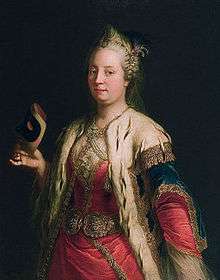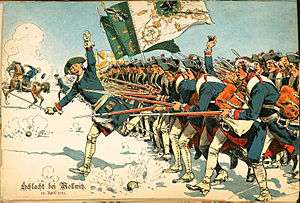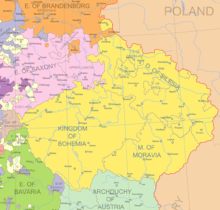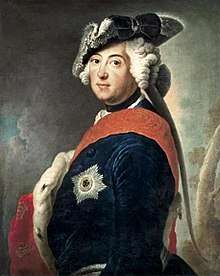First Silesian War
The First Silesian War was a theatre of the War of the Austrian Succession. The name is used to describe Prussia's war against Austria between 1740 and 1742,[1] fought mainly in Silesia, Moravia and Bohemia (the lands of the Bohemian Crown). It became the first in a series of three Silesian Wars fought between Frederick the Great's Prussia and Maria Theresa's Austria.
The war began in late 1740, when King Frederick invaded Habsburg Silesia, citing centuries-old dynastic claims to parts of the province. It ended in a Prussian victory with the 1742 Treaty of Berlin, which recognized Prussia's seizure of most of Silesia, along with the County of Glatz. Meanwhile, the wider War of the Austrian Succession continued, and Austria and Prussia would enter a renewed Second Silesian War only two years later.
Background
Prussia's claims
Brandenburg–Prussia's claims in Silesia were based, in part, on a 1537 inheritance treaty between the Silesian duke Frederick II of Legnica and the Hohenzollern Prince-Elector Joachim II Hector of Brandenburg, whereby the Silesian duchies of Liegnitz, Wohlau and Brieg were to pass to the Electorate of Brandenburg if the Silesian Piasts should become extinct. At the time, the Habsburg King Ferdinand I of Bohemia (Silesia's legal overlord) immediately rejected the agreement; nevertheless, in 1675 the "Great Elector" Frederick William of Brandenburg laid claim to the Silesian principalities when, with the death of Duke George William of Liegnitz, the Piast line ended.[2]
In 1603, Hohenzollern Elector Joachim III Frederick of Brandenburg also inherited the Silesian Duchy of Jägerndorf from his cousin, Margrave George Frederick of Brandenburg-Ansbach. However, after the Bohemian Revolt and the outbreak of the Thirty Years' War, the Catholic Holy Roman Emperor Ferdinand II confiscated the possessions of the Protestant Hohenzollerns in his Bohemian lands after winning the Battle of White Mountain in 1621. The Electors of Brandenburg continued, nevertheless, to assert themselves as the legitimate rulers of Jägerndorf.[2]
Brandenburg, however, was unable to enforce these dynastic territorial claims. In 1685, when Austria was engaged in the Great Turkish War, Emperor Leopold I gave Elector Frederick William immediate control of the Silesian exclave of Schwiebus in return for military support against the Turks and the surrender of the outstanding Hohenzollern claims in Silesia. However, after the accession of the Elector's son and successor, Frederick III of Brandenburg, the Emperor took back control of Schwiebus in 1694, asserting that the territory had only been personally assigned to the late Frederick William for life. Furious, Frederick III in turn reasserted the old Hohenzollern claims to Jägerndorf and the Silesian Piast heritage.[2]
Austrian succession

Forty-five years later, an opportunity arose for Brandenburg–Prussia to press these claims, when Habsburg Emperor Charles VI died in 1740 without a male heir. With the Pragmatic Sanction of 1713, Charles had established his eldest daughter as the successor to his hereditary titles, and upon his death she duly became ruler of the Archduchy of Austria, as well as of the Bohemian and Hungarian lands within the Habsburg Monarchy, as Archduchess Maria Theresa.[3]:24 During Emperor Charles’s lifetime, the Pragmatic Sanction was generally acknowledged by the imperial states, but when he died it was promptly contested by several parties.[4]:3100
The newly crowned King Frederick II of Prussia saw in Austria's succession crisis an opportune moment for the seizure of Silesia. Historians have downplayed the importance of his family's antique claims in the region in Frederick's decision to invade; the province was populous and industrialized, yet economic factors also seem not to have weighed heavily in the Prussian attack. Rather, geostrategic considerations probably played the leading role: Frederick believed (correctly) that Prince-Elector Frederick Augustus II of Saxony, who also ruled Poland in personal union, was interested in taking control of Silesia to connect his two realms into one contiguous territory that would almost surround Brandenburg.[5][6]:192–193
After Emperor Charles's death on 20 October, Frederick quickly resolved to strike first; on 8 November he ordered the mobilization of the Prussian army, and on 11 December he issued an ultimatum to Maria Theresa demanding the surrender of Silesia. In return, he promised to acknowledge the Pragmatic Sanction and to give his vote as elector of Brandenburg in the imperial election to Maria Theresa's husband, Duke Francis Stephen of Lorraine. Not waiting for a response, he then led his troops across the lightly defended Silesian frontier on 16 December 1740, beginning the First Silesian War.[6]:183
Alliances and goals

As Prussia reactivated its Silesian claims and prepared for war against Austria, it was joined by numerous other European powers. Prince-Elector Charles Albert of Bavaria launched a claim to the imperial throne along with the Habsburg territories of Bohemia, Upper Austria and Tyrol, while Frederick Augustus of Saxony laid claim to Moravia and Upper Silesia.[7] The kingdoms of Spain and Naples hoped to seize Habsburg possessions in northern Italy, while the Kingdom of France sought control of the Austrian Netherlands and viewed the Habsburgs as traditional rivals.[6]:194 The electorates of Cologne and the Palatinate joined these to form an alliance known as the League of Nymphenburg, which aimed at the diminution or destruction of the Habsburg Monarchy and its dominant position among the German states.[4]:3100
Austria, for its part, was supported by Great Britain (in personal union with the Electorate of Hanover) and, eventually, Savoy–Sardinia and the Dutch Republic; the Russian Empire under Tsaritsa Elizabeth also indirectly took Austria's side in the wider conflict by making war against Sweden (a French ally at the time). Maria Theresa's aims in the conflict were, first, to preserve her hereditary lands and titles and, second, to win or compel support for the election of her husband, Francis Stephen of Lorraine, as Holy Roman Emperor, defending her house's traditional preeminence within Germany.[4]:3100
Course
Silesian campaign of 1740–41

The Prussian army had massed quietly along the Oder River during early December 1740, and on 16 December, without a declaration of war, Frederick moved his army across the frontier into Silesia.[8]:3 The Prussian force consisted of two corps totaling 27,000 soldiers, while all of Silesia was defended by an Austrian garrison of only 8,000 men.[6]:183,192 The Austrians were only able to offer light resistance and garrison a few fortresses; the Prussians swept through the province, taking control of the capital at Breslau without a fight on 2 January 1741.[9] The fortress at Ohlau was also taken without resistance on 9 January,[9] after which the Prussians used it for their winter quarters.[3]:177 By the end of January 1741, almost the entirety of Silesia had come under Prussian control, and the remaining Austrian strongholds of Glogau, Brieg and Neisse were besieged.[6]:183
After leaving winter quarters in early 1741, the Prussian forces began a spring campaign, and on 9 March Prince Leopold II of Anhalt-Dessau took Glogau by storm. In late March, an Austrian force of around 20,000 under the command of Wilhelm Reinhard von Neipperg crossed the Sudetes from Moravia to break the siege of Neisse, and the main Prussian force maneuvered to oppose its advance.[9] The two armies engaged each other near the village of Mollwitz on 10 April, where the Prussians under Marshal Kurt von Schwerin defeated the Austrians in the Battle of Mollwitz.[10] The Prussian siege of Neisse had been lifted as Neipperg's army approached, but Brieg surrendered to the Prussians on 4 May,[9] after which the main Prussian force encamped through the summer near Neisse, facing off against Neipperg's Austrians but fighting little.[11]
Negotiations of summer 1741

After Austria's defeat at Mollwitz, other powers were emboldened to attack the beleaguered archduchy, widening the conflict into what would become the War of the Austrian Succession.[6]:193–194 France declared its support for Prussia's seizure of Silesia in the 5 June Treaty of Breslau,[12][3]:181 and in July it joined in the Treaty of Nymphenburg, by which France and Spain committed to support Bavaria's territorial claims against Austria. French forces began crossing the Rhine on 15 August,[7] joining the Bavarian Elector's forces on the Danube and advancing toward Vienna,[3]:223 while a Spanish–Neapolitan army attacked Austria's holdings in northern Italy.[13] The Franco-Bavarian force seized Linz on 14 September and advanced through Upper Austria, reaching the vicinity of Vienna by October, while Bohemia was simultaneously invaded by the Saxons (who joined the alliance against Austria on 19 September).[7]
As new enemies attacked Austria on multiple fronts, King Frederick conducted secret peace negotiations with Neipperg in Breslau, even as he continued to publicly support the League of Nymphenburg. Although Frederick was allied with the French, the idea of France becoming the dominant power in Germany (through Austria's destruction) did not appeal to him. With British urging and mediation,[7] on 9 October Austria and Prussia agreed to a secret armistice known as the Convention of Klein-Schnellendorf, under which both belligerents would cease hostilities in Silesia (though maintaining their appearance), and Austria would eventually concede Lower Silesia in return for a final peace to be negotiated before the end of the year.[14] Neipperg's Austrian forces were then recalled from Silesia to defend Austria against the western invaders, abandoning Neisse after a sham siege and leaving the whole of Silesia under Prussian control.[11][3]:223–224
Bohemia–Moravia campaign of 1741–42
In mid October, Charles Albert of Bavaria and his French allies were encamped near Vienna, ready to besiege the Austrian capital. However, the Elector became concerned that Saxony and Prussia would seize parts of Bohemia, which he had also claimed, and on 24 October his force turned north to march on Prague. The Bavarian, French and Saxon armies converged around that city in November, besieging it and ultimately storming it on 26 November; Charles Albert went on to proclaim himself King of Bohemia on 7 December.[7] Meanwhile, in early November Frederick negotiated the border between putative territories of Prussian Silesia and Saxon Bohemia–Moravia with Frederick Augustus, also securing French and Bavarian support for his seizure of the entirety of Silesia, along with the Bohemian County of Glatz. As the end of the year approached without any sign of a formal peace treaty, Frederick concluded that the Austrians did not intend to honor the Convention of Klein-Schnellendorf and concede territory in Silesia; so, to press Austria further, he repudiated the Convention and renewed offensive operations of his own.[11]
In December, Kurt von Schwerin's army advanced through the Sudetes into Moravia, occupying the capital at Olmütz on 27 December, while Prince Leopold's army besieged the fortress at Glatz on the edge of Bohemia. In early 1742, Frederick organized a joint advance through Moravia toward Vienna with the Saxons and French, which began after their forces met on 5 February at Wischau; the French, however, were reluctant and uncooperative, and, after the seizure of Iglau on 15 February, they withdrew into Bohemia. The Prussians and Saxons marched on toward Brünn, the main Austrian stronghold remaining in Moravia, but they made little progress due to the substantial Austrian garrison and a shortage of supplies.[14] This Moravian campaign achieved no significant gains, and the effort was finally abandoned on 5 April, after which the Prussians withdrew into Bohemia and Upper Silesia.[11][8]:4
As the Moravian advance collapsed, Charles of Lorraine (Maria Theresa's brother-in-law) led an Austro-Hungarian army of 30,000 through Moravia toward Bohemia, hoping to liberate Prague. In early May, a Prussian army of 28,000 led by King Frederick and Prince Leopold marched into the plains of the Elbe southeast of Prague, maneuvering to block the Austrian advance.[13]:103 The two armies met when Charles's Austrians attacked Prince Leopold's camp near the village of Chotusitz on 17 May; the resulting Battle of Chotusitz ended in a narrow Prussian victory, with substantial casualties on both sides. Prince Charles's defeat at Chotusitz, followed shortly by the defeat of another Austrian army at the 24 May Battle of Sahay, left Prague securely in the invaders' hands and Austria with no immediate means of driving them out of Bohemia.[11]
Treaties of Breslau and Berlin
In the aftermath of Chotusitz, Frederick learned that the French had begun secret moves toward a separate peace with Austria. Hoping to cement his own gains in Silesia, he, too, began renewed peace talks with Austrian negotiators, held again in Breslau. Frederick now demanded the whole of Silesia, as well as the County of Glatz, concessions which Maria Theresa was reluctant to make; however, the British envoy, Lord Hyndford, pressed her to make peace with Prussia and concentrate her forces against the French.[14] The British treasury had financed much of Austria's war effort through cash subsidies, and Hyndford threatened now to withdraw Britain's support if Maria Theresa refused to give up the Silesian War for lost.[11] The two belligerents eventually reached an agreement in the 11 June Treaty of Breslau, which ended the First Silesian War.[15]
Under this treaty, Austria conceded to Prussia the large majority of Silesia, along with the County of Glatz, territories which would later be consolidated to form the Prussian Province of Silesia. Austria retained two small portions of the extreme southern end of Silesia, including the Duchy of Teschen and parts of the Duchies of Jägerndorf, Troppau, and Neisse; these lands would later be combined to form the crown land of Austrian Silesia. Prussia also agreed to take on some of Austria's debts that had been secured against assets in Silesia, as well as committing to remain neutral for the remainder of the ongoing War of the Austrian Succession. This arrangement was formalized and confirmed in the Treaty of Berlin, signed 28 July 1742.[11]
Outcomes

The First Silesian War ended in a decisive victory for Prussia; Prussia secured new territory in Silesia and Glatz, and the kingdom's prestige was greatly enhanced. However, by making a separate peace while the wider War of the Austrian Succession raged on, King Frederick betrayed his erstwhile allies in the League of Nymphenburg and earned a reputation for diplomatic unreliability and double-dealing.[14][12] Maria Theresa's determination to recover Silesia would lead to renewed conflict with Prussia in the Second Silesian War only two years later, with a Third Silesian War to follow after another decade.[1]
Prussia
In the territorial settlement that ended the war, Prussia gained control of extensive new lands in Silesia, a densely industrialized region (for the time period) with a large population and substantial tax yields.[6]:192 The small kingdom's unexpected victory over the Habsburg Monarchy marked the beginning of Prussia's rise toward the status of a European great power, as it began to leave German rivals such as Bavaria and Saxony behind.[6]:196
However, this success planted the seeds of future difficulties. Prussia's seizure of Silesia made Austria into a lasting and determined enemy, beginning the Austria–Prussia rivalry that would come to dominate German politics over the next century.[6]:216 King Frederick's unilateral withdrawal from the Nymphenburg alliance (and its repetition at the end of the Second Silesian War) turned sentiment in the French royal court against him, contributing to France's eventual realignment toward Austria in the Diplomatic Revolution of the 1750s; France would later oppose Prussia in the Third Silesian War.[6]:210–211
Austria
The Treaties of Breslau and Berlin cost the Habsburg Monarchy its wealthiest province, and capitulating to a lesser German prince significantly dented the House of Habsburg's prestige.[6]:192,196 However, peace in the Silesian theater gave the united Austrian and British–Hanoverian forces a free hand to reverse the gains made by the French and Bavarians in 1741. By the summer of 1743, the Austrians would recover control of Bohemia, drive the French back across the Rhine into Alsace, and occupy Bavaria, exiling the Bavarian Elector (now crowned Holy Roman Emperor Charles VII) to Frankfurt.[4]:3103
References
- 1 2 "Silesian Wars". Encyclopædia Britannica. Retrieved 4 August 2017.
- 1 2 3 Carlyle, Thomas (1858). History of Friedrich II of Prussia, Called Frederick the Great. Book III.
- 1 2 3 4 5 Asprey, Robert B. (1986). Frederick the Great: The Magnificent Enigma. New York: Ticknor and Fields.
- 1 2 3 4 Clifford, John Herbert (1914). The Standard History of the World, by Great Historians. Volume 5. University Society. Retrieved 24 August 2017.
- ↑ Davies, Norman (1982). God's Playground: A History of Poland: Volume I: The Origins to 1795. New York: Columbia University Press. p. 507.
- 1 2 3 4 5 6 7 8 9 10 11 Clark, Christopher (2006). Iron Kingdom: The Rise and Downfall of Prussia, 1600–1947. Belknap Press. ISBN 978-0-674-03196-8.
- 1 2 3 4 5 Black, Jeremy (2002). European International Relations 1648–1815. Palgrave Macmillan. p. 102–103. ISBN 9781137223920.
- 1 2 Luvaas, Jay (1966). Frederick the Great on the Art of War. New York: Free Press. ISBN 978-0-7867-4977-5.
- 1 2 3 4 Carlyle, Thomas (1858). History of Friedrich II of Prussia, Called Frederick the Great. Book XII.
- ↑ Showalter, Dennis, E (1996). The Wars of Frederick the Great. Longman. ISBN 0-582-06260-8.
- 1 2 3 4 5 6 7 Carlyle, Thomas (1858). History of Friedrich II of Prussia, Called Frederick the Great. Book XIII.
- 1 2 Shennan, J. H. (2005). International Relations in Europe, 1689-1789. Routledge. p. 43. ISBN 9781134899968.
- 1 2 Browning, Reed (1993). The War of the Austrian Succession. New York: St. Martin's Press. ISBN 0-312-09483-3.
- 1 2 3 4 Holborn, Hajo (1982). A History of Modern Germany: 1648–1840. Princeton University Press. p. 213. ISBN 9780691007960.
- ↑ Atkinson, Charles Francis (1911). "Austrian Succession, War of the". Encyclopædia Britannica. 3.
External links

